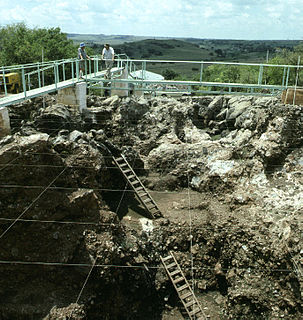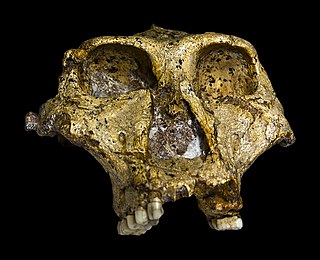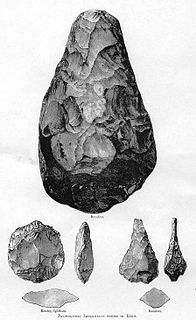
Bipedalism is a form of terrestrial locomotion where an organism moves by means of its two rear limbs or legs. An animal or machine that usually moves in a bipedal manner is known as a biped, meaning 'two feet'. Types of bipedal movement include walking, running, and hopping.

John Griffith Chaney, better known as Jack London, was an American novelist, journalist and activist. A pioneer of commercial fiction and American magazines, he was one of the first American authors to become an international celebrity and earn a large fortune from writing. He was also an innovator in the genre that would later become known as science fiction.

The Cradle of Humankind is a paleoanthropological site and is located about 50 km (31 mi) northwest of Johannesburg, South Africa, in the Gauteng province. Declared a World Heritage Site by UNESCO in 1999, the site is home to the largest concentration of human ancestral remains anywhere in the world. The site currently occupies 47,000 hectares (180 sq mi) and contains a complex system of limestone caves. The registered name of the site in the list of World Heritage Sites is Fossil Hominid Sites of South Africa.

Sterkfontein is a set of limestone caves of special interest to paleo-anthropologists located in Gauteng province, about 40 kilometres (25 mi) northwest of Johannesburg, South Africa in the Muldersdrift area close to the town of Krugersdorp. The archaeological sites of Swartkrans and Kromdraai are in the same area. Sterkfontein is a South African National Heritage Site and was also declared a World Heritage Site in 2000. The area in which it is situated is known as the Cradle of Humankind. The Sterkfontein Caves are also home to numerous wild African species including Belonogaster petiolata, a wasp species of which there is a large nesting presence.

Homo rhodesiensis is the species name proposed by Arthur Smith Woodward (1921) to classify Kabwe 1, a Middle Stone Age fossil recovered from a cave at Broken Hill, or Kabwe, Northern Rhodesia .. In 2020, the skull was dated to 324,000 to 274,000 years ago. Other similar older specimens also exist.

Aris Poulianos is a Greek anthropologist and archaeologist.

Swartkrans is a fossil-bearing cave designated as a South African National Heritage Site, located about 32 km (20 mi) from Johannesburg. It is located in the Cradle of Humankind World Heritage Site and is notable for being extremely rich in archaeological material, particularly hominin remains. Fossils discovered in the limestone of Swartkrans include Homo ergaster, Paranthropus and Homo habilis. The oldest deposits present at the site are believed to be between 1.9 and 2.1 million years old.

Adam and Eve, according to the creation myth of the Abrahamic religions, were the first man and woman. They are central to the belief that humanity is in essence a single family, with everyone descended from a single pair of original ancestors. They also provide the basis for the doctrines of the fall of man and original sin that are important beliefs in Christianity, although not held in Judaism or Islam.
The control of fire by early humans was a critical technology enabling the evolution of humans. Fire provided a source of warmth and lighting, protection from predators, a way to create more advanced hunting tools, and a method for cooking food. These cultural advances allowed human geographic dispersal, cultural innovations, and changes to diet and behavior. Additionally, creating fire allowed human activity to continue into the dark and colder hours of the evening.

Wushan Man is a set of fossilised remains of an extinct, undetermined non-hominin ape found in central China in 1985. The remains are dated to around 2 million years ago and were originally considered to represent a subspecies of Homo erectus.
Balangoda Man refers to hominins from Sri Lanka's late Quaternary period. The term was initially coined to refer to anatomically modern Homo sapiens from sites near Balangoda that were responsible for the island's Mesolithic 'Balangoda Culture'. The earliest evidence of Balangoda Man from archaeological sequences at caves and other sites dates back to 38,000 BP, and from excavated skeletal remains to 30,000 BP, which is also the earliest reliably dated record of anatomically modern humans in South Asia. Cultural remains discovered alongside the skeletal fragments include geometric microliths dating to 28,500 BP, which together with some sites in Africa is the earliest record of such stone tools.
Belilena is a well known large cave in Sri Lanka, located 8 km (5.0 mi) from the town of Kitulgala. Evidence of prehistoric human presence as early as 32,000 years ago was recorded at the site. The skeletal remains of ten individuals were discovered by Paul E. P. Deraniyagala, who attributed them to Balangoda Man. Balangoda Man is assumed to have lived as early as 32,000 years ago and occupied high altitude territories of up to 2,000 ft (609.6 m) above sea level.

The Bontnewydd palaeolithic site, also known in its unmutated form as Pontnewydd, is an archaeological site near St Asaph, Denbighshire, Wales. It is one of only three sites in Britain to have produced fossils of ancient species of humans and the only one with fossils of a classic Neanderthal. It is located a few yards east of the River Elwy, near the hamlet of Bontnewydd, near Cefn Meiriadog, Denbighshire.

Prehistoric Indonesia is a prehistoric period in the Indonesian archipelago that spanned from the Pleistocene period to about the 4th century CE when the Kutai people produced the earliest known stone inscriptions in Indonesia. Unlike the clear distinction between prehistoric and historical periods in Europe and the Middle East, the division is muddled in Indonesia. This is mostly because Indonesia's geographical conditions as a vast archipelago caused some parts — especially the interiors of distant islands — to be virtually isolated from the rest of the world. West Java and coastal Eastern Borneo, for example, began their historical periods in the early 4th century, but megalithic culture still flourished and script was unknown in the rest of Indonesia, including in Nias, Batak, and Toraja. The Papuans on the Indonesian part of New Guinea island lived virtually in the Stone Age until their first contacts with modern world in the early 20th century. Even today living megalithic traditions still can be found on the island of Sumba and Nias.

Malapa is a fossil-bearing cave located about 15 kilometres (9.3 mi) northeast of the well known South African hominid-bearing sites of Sterkfontein and Swartkrans and about 45 kilometres (28 mi) north-northwest of Johannesburg, South Africa. It is situated within the Cradle of Humankind World Heritage Site.
Prehistoric technology is technology that predates recorded history. History is the study of the past using written records. Anything prior to the first written accounts of history is prehistoric, including earlier technologies. About 2.5 million years before writing was developed, technology began with the earliest hominids who used stone tools, which they may have used to start fires, hunt, and bury their dead.

The following outline is provided as an overview of and topical guide to prehistoric technology.

Engis 2 refers to part of an assemblage, discovered in 1829 by Dutch physician and naturalist Philippe-Charles Schmerling in the lower of the Schmerling Caves. The pieces that make up Engis 2 are a partially preserved calvaria (cranium) and associated fragments of an upper and a lower jaw, a maxillary bone and an upper incisor tooth of a two to three year old Neanderthal child. The Schmerling Caves are situated just north of the Belgian municipality Engis, whence the name of this group. In 1833 Schmerling described and publicized the find, which included animal bones and stone tools. Recognizing their old age, he associated them with the "Ethiopian Type" of the diluvial period. Although it was not recognized as such until 1936, the publication represents the first scientific description of a Neanderthal fossil.
The Apidima Cave is a complex of four small caves located on the western shore of Mani Peninsula in Southern Greece. A systematic investigation of the cave has yielded Neanderthal and Homo sapiens fossils from the Palaeolithic era.














